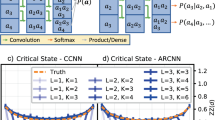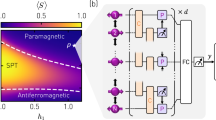Abstract
Neural network-based machine learning has recently proven successful for many complex applications ranging from image recognition to precision medicine. However, its direct application to problems in quantum physics is challenging due to the exponential complexity of many-body systems. Motivated by recent advances in realizing quantum information processors, we introduce and analyse a quantum circuit-based algorithm inspired by convolutional neural networks, a highly effective model in machine learning. Our quantum convolutional neural network (QCNN) uses only O(log(N)) variational parameters for input sizes of N qubits, allowing for its efficient training and implementation on realistic, near-term quantum devices. To explicitly illustrate its capabilities, we show that QCNNs can accurately recognize quantum states associated with a one-dimensional symmetry-protected topological phase, with performance surpassing existing approaches. We further demonstrate that QCNNs can be used to devise a quantum error correction scheme optimized for a given, unknown error model that substantially outperforms known quantum codes of comparable complexity. The potential experimental realizations and generalizations of QCNNs are also discussed.
This is a preview of subscription content, access via your institution
Access options
Access Nature and 54 other Nature Portfolio journals
Get Nature+, our best-value online-access subscription
$29.99 / 30 days
cancel any time
Subscribe to this journal
Receive 12 print issues and online access
$209.00 per year
only $17.42 per issue
Buy this article
- Purchase on Springer Link
- Instant access to full article PDF
Prices may be subject to local taxes which are calculated during checkout





Similar content being viewed by others
Data availability
The data that support the plots within this paper and other findings of this study are available from the corresponding author on reasonable request.
References
LeCun, Y., Bengio, Y. & Hinton, G. Deep learning. Nature 521, 436–444 (2015).
Lin, H. W., Tegmark, M. & Rolnick, D. Why does deep and cheap learning work so well? J. Stat. Phys. 168, 1223–1247 (2017).
Mehta, P. & Schwab, D. J. An exact mapping between the variational renormalization group and deep learning. Preprint at https://arxiv.org/abs/1410.3831 (2014).
Carleo, G. & Troyer, M. Solving the quantum many-body problem with artificial neural networks. Science 355, 602–606 (2017).
van Nieuwenburg, E. P. L., Liu, Y. H. & Huber, S. D. Learning phase transitions by confusion. Nat. Phys. 13, 435–439 (2017).
Carrasquilla, J. & Melko, R. G. Machine learning phases of matter. Nat. Phys. 13, 431–434 (2017).
Wang, L. Discovering phase transitions with unsupervised learning. Phys. Rev. B 94, 195105 (2016).
Levine, Y., Cohen, N. & Shashua, A. Quantum entanglement in deep learning architectures. Phys. Rev. Lett. 122, 065301 (2019).
Zhang, Y. & Kim, E.-A. Quantum loop topography for machine learning. Phys. Rev. Lett. 118, 216401 (2017).
Maskara, N., Kubica, A. & Jochym-O’Connor, T. Advantages of versatile neural-network decoding for topological codes. Phys. Rev. A 99, 052351 (2019).
Haah, J., Harrow, A. W., Ji, Z., Wu, X. & Yu, N. Sample-optimal tomography of quantum states. IEEE Trans. Inform. Theory 63, 5628–5641 (2017).
Lee, J. Y. & Landon-Cardinal, O. Practical variational tomography for critical one-dimensional systems. Phys. Rev. A 91, 062128 (2019).
Ladd, T. D. et al. Quantum computers. Nature 464, 45–53 (2010).
Monroe, C. & Kim, J. Scaling the ion trap quantum processor. Science 339, 1164–1169 (2013).
Devoret, M. H. & Schoelkopf, R. J. Superconducting circuits for quantum information: an outlook. Science 339, 1169–1174 (2013).
Awschalom, D. D., Bassett, L. C., Dzurak, A. S., Hu, E. L. & Petta, J. R. Quantum spintronics: engineering and manipulating atom-like spins in semiconductors. Science 339, 1174–1179 (2013).
Biamonte, J. et al. Quantum machine learning. Nature 549, 195–202 (2017).
Dunjko, V., Taylor, J. M. & Briegel, H. J. Quantum-enhanced machine learning. Phys. Rev. Lett. 117, 130501 (2016).
Farhi, E. & Neven, H. Classification with quantum neural networks on near term processors. Preprint at https://arxiv.org/abs/1802.06002 (2018).
Huggins, W., Patil, P., Mitchell, B., Whaley, K. B. & Stoudenmire, E. M. Towards quantum machine learning with tensor networks. Quantum Sci. Technol. 4, 024001 (2018).
Huang, C.-Y., Chen, X. & Lin, F.-L. Symmetry-protected quantum state renormalization. Phys. Rev. B 88, 205124 (2013).
Singh, S. & Vidal, G. Symmetry-protected entanglement renormalization. Phys. Rev. B 88, 121108(R) (2013).
Kim, I. & Swingle, B. Robust entanglement renormalization on a noisy quantum computer. Preprint at https://arxiv.org/abs/1711.07500 (2017).
LeCun, Y. & Bengio, Y. in The Handbook of Brain Theory and Neural Networks 255–258 (MIT Press, 1995).
Krizhevsky, A., Sutskever, I. & Hinton, G. E. Imagenet classification with deep convolutional neural networks. In Proc. 25th Int. Conf. Neural Information Processing Systems Vol. 1, 1097–1105 (2012).
Vidal, G. Class of many-body states that can be efficiently simulated. Phys. Rev. Lett. 101, 110501 (2008).
Aguado, M. & Vidal, G. Entanglement renormalization and topological order. Phys. Rev. Lett. 100, 070404 (2008).
Pfeifer, R. N. C., Evenbly, G. & Vidal, G. Entanglement renormalization, scale invariance, and quantum criticality. Phys. Rev. A 79, 040301 (2009).
Preskill, J. Lecture Notes for Physics 229: Quantum Information and Computation. (California Institute of Technology, 1998).
Sachdev, S. Quantum Phase Transitions (Cambridge University Press, 2011).
Haldane, F. D. M. Nonlinear field theory of large-spin Heisenberg antiferromagnets: semiclassically quantized solitons of the one-dimensional easy-axis Néel state. Phys. Rev. Lett. 50, 1153 (1983).
Haegeman, J., Pérez-García, D., Cirac, I. & Schuch, N. Order parameter for symmetry-protected topological phases in one dimension. Phys. Rev. Lett. 109, 050402 (2012).
Pollmann, F. & Turner, A. M. Detection of symmetry-protected topological phases in one dimension. Phys. Rev. B 86, 125441 (2012).
Brown, L. D., Cai, T. T. & DasGupta, A. Interval estimation for a binomial proportion. Stat. Sci. 16, 101 (2001).
Zeng, B. & Zhou, D. L. Topological and error-correcting properties for symmetry-protected topological order. Eur. Phys. Lett. 113, 56001 (2016).
Schwarz, M., Temme, K. & Verstraete, F. Preparing projected entangled pair states on a quantum computer. Phys. Rev. Lett. 108, 110502 (2012).
Ge, Y., Molnar, A. & Cirac, J. I. Rapid adiabatic preparation of injective projected entangled pair states and Gibbs states. Phys. Rev. Lett. 116, 080503 (2016).
Shor, P. Scheme for reducing decoherence in quantum computer memory. Phys. Rev. A 52, R2493(R) (1995).
Bernien, H. et al. Probing many-body dynamics on a 51-atom quantum simulator. Nature 551, 579–584 (2017).
Zhang, J. et al. Observation of a many-body dynamical phase transition with a 53-qubit quantum simulator. Nature 551, 601–604 (2017).
Brydges, T. et al. Probing Rényi entanglement entropy via randomized measurements. Science 364, 260–263 (2019).
Harris, R. et al. Phase transitions in a programmable quantum spin glass simulator. Science 361, 162–165 (2018).
Labuhn, H. et al. Tunable two-dimensional arrays of single Rydberg atoms for realizing quantum ising models. Nature 534, 667–670 (2016).
Levine, H. et al. High-fidelity control and entanglement of Rydberg atom qubits. Phys. Rev. Lett. 121, 123603 (2018).
Freeman, R. Shaped radiofrequency pulses in high resolution NMR. Progr. Nucl. Magn. Reson. Spectrosc. 32, 59–106 (1998).
Kitaev, A. Y. Fault-tolerant quantum computation by anyons. Ann. Phys. 303, 2–30 (2003).
Levin, M. A. & Wen, X.-G. String-net condensation: a physical mechanism for topological phases. Phys. Rev. B. 71, 045110 (2005).
Schuch, N., Pérez-García, D. & Cirac, J. I. PEPS as ground states: degeneracy and topology. Ann. Phys. 325, 2153 (2010).
Savary, L. & Balents, L. Quantum spin liquids: a review. Rep. Prog. Phys. 80, 016502 (2017).
Feiguin, A. et al. Interacting anyons in topological quantum liquids: the golden chain. Phys. Rev. Lett. 98, 160409 (2007).
McCulloch, I. P. Infinite size density matrix renormalization group, revisited. Preprint at https://arxiv.org/abs/0804.2509 (2008).
Vidal, G. Efficient classical simulation of slightly entangled quantum computations. Phys. Rev. Lett. 91, 147902 (2003).
Nielsen, M. A. & Chuang, I. Quantum Computation and Quantum Information (Cambridge Univ. Press, 2000).
Verresen, R., Moessner, R. & Pollman, F. One-dimensional symmetry-protected topological phases and their transitions. Phys. Rev. B 96, 165124 (2017).
Bertlmann, R. A. & Krammer, P. Bloch vectors for qudits. J. Phys. A 41,, 235303 (2008).
Hinton, G. Lecture notes for CSC2515: Introduction to machine learning (Univ. Toronto, 2007).
Schuch, N., Pérez-García, D. & Cirac, J. I. Classifying quantum phases using matrix product states and projected entangled pair states. Phys. Rev. B 84, 165139 (2011).
Chen, X., Gu, Z.-C. & Wen, X.-G. Classification of gapped symmetric phases in one-dimensional spin systems. Phys. Rev. B 83, 035107 (2011).
Aharonov, D. & Ben-Or, M. in Proc. 29th Annu. ACM Symp. on the Theory of Computing 176–188 (ACM, 1997).
Saffman, M., Walker, T. & Molmer, K. Quantum information with Rydberg atoms. Rev. Mod. Phys. 82, 2313 (2010).
Acknowledgements
We thank I. Cirac, E. Farhi, W. W. Ho, C. Nayak, H. Pichler, J. Preskill, X. Qi, A. Vishwanath, Z. Wang and X.-G. Wen for insightful discussions. I.C. acknowledges support from the Paul and Daisy Soros Fellowship, the Alfred Spector and Rhonda Kost Fellowship of the Hertz Foundation, and the Department of Defense through the National Defense Science and Engineering Graduate Fellowship Program. S.C. acknowledges support from the Miller Institute for Basic Research in Science. This work was supported through the National Science Foundation, the Center for Ultracold Atoms, the Vannevar Bush Faculty Fellowship and Google Research Award.
Author information
Authors and Affiliations
Contributions
All authors contributed extensively to the work presented in this paper.
Corresponding author
Ethics declarations
Competing interests
The authors declare no competing interests.
Additional information
Peer review information: Nature Physics thanks Zohar Ringel and the other, anonymous, reviewer(s) for their contribution to the peer review of this work.
Publisher’s note: Springer Nature remains neutral with regard to jurisdictional claims in published maps and institutional affiliations.
Supplementary information
Supplementary Information
Supplementary Figs. 1–4.
Rights and permissions
About this article
Cite this article
Cong, I., Choi, S. & Lukin, M.D. Quantum convolutional neural networks. Nat. Phys. 15, 1273–1278 (2019). https://doi.org/10.1038/s41567-019-0648-8
Received:
Accepted:
Published:
Issue Date:
DOI: https://doi.org/10.1038/s41567-019-0648-8
This article is cited by
-
Correlated optical convolutional neural network with “quantum speedup”
Light: Science & Applications (2024)
-
Enhancing detection of topological order by local error correction
Nature Communications (2024)
-
A framework for demonstrating practical quantum advantage: comparing quantum against classical generative models
Communications Physics (2024)
-
Understanding quantum machine learning also requires rethinking generalization
Nature Communications (2024)
-
Theoretical guarantees for permutation-equivariant quantum neural networks
npj Quantum Information (2024)



